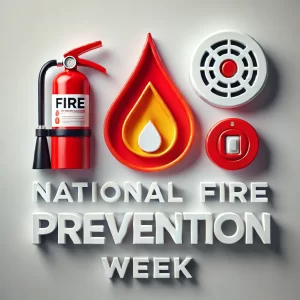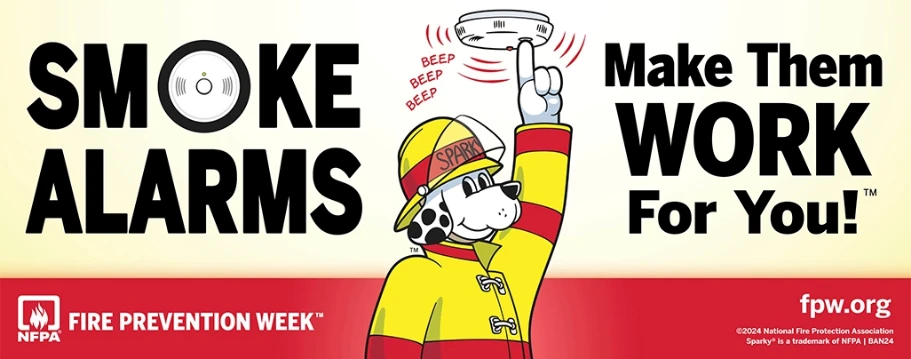The Importance of Fire Prevention
Overview of National Fire Prevention Week (NFPW)
National Fire Prevention Week (NFPW) plays a vital role in promoting fire safety. Every October, this campaign raises awareness about fire prevention. NFPW educates people on how to avoid fires and protect their families.
The 2024 Theme: “Smoke Alarms: Make Them Work for You”
The 2024 theme focuses on the importance of smoke alarms. It emphasizes testing, installing, and replacing smoke alarms regularly. Properly functioning alarms reduce the risk of fatalities in house fires by more than half.
Why Fire Prevention Education Matters
Fire prevention saves lives and property. Education empowers people to understand fire risks and take preventive measures. National Fire Prevention Week encourages individuals and communities to prioritize fire safety.
The Role of Smoke Alarms in Fire Prevention
Installation: Where and How to Set Up Smoke Alarms
Proper placement of smoke alarms makes a big difference in fire safety. Install alarms in every bedroom, outside sleeping areas, and on each home level. Ensure smoke alarms are placed in basements and hallways, where fires can spread quickly.
Maintenance: Regular Testing and Replacement
Test smoke alarms once a month to ensure they work. Replace alarms every ten years, or when they stop responding during tests. Following these steps helps keep your family safe from fire emergencies.
Here’s a quick reference table summarizing key facts and guidelines for ensuring your smoke alarms work effectively. Use this as a simple guide to maintain fire safety in your home.
| Smoke Alarm Guideline | Recommendation | Importance |
| Placement | Install in every bedroom, outside sleeping areas, and on each home level. | Ensures early detection in key areas, giving occupants more time to escape. |
| Testing | Test smoke alarms at least once a month. | Regular testing confirms alarms are functioning when needed most. |
| Replacement | Replace alarms every 10 years or if they stop responding to tests. | Old alarms may not function properly, putting lives at risk. |
| Batteries | Replace batteries once a year unless using 10-year sealed batteries. | Ensures smoke alarms remain powered and reliable throughout the year. |
| Smoke Alarm Benefits | Reduces the risk of dying in a house fire by 54%. | Working alarms significantly increase survival chances during a fire. |
Impact of Smoke Alarms on Fire Safety
Smoke alarms reduce the risk of death in house fires by 54%. Homes with no alarms or non-working alarms account for most fire-related deaths. Regular testing and proper placement of alarms are crucial for household safety.
Educational Campaigns and Community Involvement

The NFPA’s Role in Promoting Fire Safety
The National Fire Protection Association (NFPA) leads the effort to promote fire prevention. Each year, NFPA organizes Fire Prevention Week, offering resources for schools and communities. Their materials help spread critical fire safety information.
How Schools, Fire Departments, and Communities Participate
Schools and fire departments collaborate to teach fire safety during Fire Prevention Week. Firefighters visit schools to demonstrate safety tips. Communities hold workshops to raise awareness about fire prevention and proper smoke alarm usage.
Webinars, Toolkits, and Activities for 2024
The NFPA offers free webinars to explain the 2024 theme. Communities can access toolkits, lesson plans, and activity sheets. These resources make it easy to teach people of all ages how to stay safe in the event of a fire.
3 Practical Tips for Ensuring Fire Safety at Home
Tip 1: Test Smoke Alarms Monthly
Testing your smoke alarms monthly is simple. Press the test button on each device to ensure it’s working properly.
Tip 2: Create and Practice a Fire Escape Plan
Make a fire escape plan for your household. Practice it with everyone so they know how to evacuate quickly in an emergency.
Tip 3: Replace Smoke Alarms After 10 Years
Smoke alarms wear out after ten years. Regularly check the manufacture date and replace old alarms to keep your home safe.
Understanding Fire Risks in Modern Homes
The Role of Synthetic Materials in Fire Spread
Modern homes contain many synthetic materials. These materials burn faster and hotter than traditional ones. This increased speed gives families less time to escape during a fire.
The Time Factor: How Quickly Fires Escalate
Fires escalate rapidly, often spreading within minutes. The materials used in homes today emit toxic fumes, making quick evacuation essential.
Why Smoke Alarms Are Critical for Early Detection
Smoke alarms alert families to fires early, giving them time to evacuate. This early warning can be the difference between life and death.
The History and Legacy of National Fire Prevention Week
The Great Chicago Fire and Its Impact on Fire Safety
The Great Chicago Fire of 1871 sparked the creation of Fire Prevention Week. This tragic fire highlighted the need for public fire safety education and better building standards.
Evolution of Fire Safety Laws and Standards
Since 1925, Fire Prevention Week has promoted fire safety awareness. Over the years, laws and standards have evolved to improve home fire prevention and building codes.
Key Takeaways from the 2024 Campaign
What Communities Can Do to Support Fire Safety
Communities can support fire safety by hosting events, distributing toolkits, and offering workshops. Local governments can work with fire departments to spread awareness about proper smoke alarm maintenance.
The Long-Term Impact of Fire Prevention Education
Continuous fire prevention education saves lives. Teaching both adults and children how to stay safe during a fire reduces long-term fire risks in every community.
FAQ
Q1: How often should smoke alarms be tested?
Smoke alarms should be tested once a month. Regular testing ensures they work during emergencies.
Q2: What are the most common causes of home fires?
Cooking and heating equipment are the leading causes of home fires. Keep flammable objects away from stoves and heaters.
Q3: Where should I install smoke alarms in my home?
Install smoke alarms in every bedroom, outside sleeping areas, and on each level of your home. Don’t forget hallways and basements.
Q4: How can I teach my children about fire safety?
Start with basic fire safety rules. Practice escape plans and teach children how to recognize smoke alarms and react quickly.
Ensuring a Fire-Safe Future
Commitment to Fire Safety: A Year-Round Effort
Fire prevention is not a one-time task. Families, businesses, and communities need to make fire safety an ongoing priority. Regular maintenance of smoke alarms is essential, but fire prevention goes beyond that. Creating an environment that minimizes fire risks through regular safety checks, updating escape plans, and staying informed about the latest fire safety guidelines can make a significant impact. Firefighters often encourage communities to hold fire drills more than once a year to ensure everyone knows their role in case of an emergency.
Year-round fire prevention can also include installing fire-resistant materials during home renovations, especially in areas prone to wildfires. Local fire departments, schools, and community groups should collaborate to keep fire safety on the public’s mind throughout the year. Fire safety awareness days, fire prevention workshops, and continuous community outreach play an essential role in maintaining a fire-conscious society.
How Technology is Enhancing Fire Safety
Technological advances are rapidly changing fire prevention and response methods. Today’s smoke alarms come with interconnected systems, ensuring that if one alarm goes off, all alarms in the house will sound, giving families more time to escape. Many alarms also feature voice alerts, which can be more effective for waking children than standard beeping sounds.
New innovations like smart smoke detectors can be connected to mobile devices, providing real-time alerts when an alarm goes off, even when you’re not home. This allows for quicker emergency response times and can prevent significant damage. Additionally, heat-sensing technologies are being integrated into these systems to provide more accurate detection, reducing the occurrence of false alarms.
Fire suppression technology has also evolved, with automatic sprinkler systems and fire suppression gels being more accessible to homeowners. Innovations like drones and robots assist firefighters in high-risk environments, improving safety and efficiency. Homeowners can also benefit from newer fire extinguishing tools designed for faster deployment and ease of use. Modern systems allow firefighters to monitor fires remotely, using artificial intelligence to predict fire patterns and manage resources effectively.
As the world moves forward with smart home technologies, incorporating fire safety into your home automation system should be a priority. For example, connecting smoke alarms to your home’s security system can provide immediate notifications to emergency services, offering an extra layer of protection.
References
Here are some resources from reputable sources to learn more about National Fire Prevention Week:
1. National Fire Protection Association (NFPA)
Make Smoke Alarms Work for You! (https://www.nfpa.org/en)
The NFPA is the leading organization on fire safety and sponsors National Fire Prevention Week.
2. U.S. Fire Administration (USFA)
Fire Prevention Week 2024 (https://www.usfa.fema.gov/)
The USFA is a government agency focused on fire safety programs.
3. Sparkyschoolhouse.org
Fire Safety Activities for Kids (https://sparkyschoolhouse.org/for-educators/)
Sparkyschoolhouse.org is an educational website from the NFPA designed for children.
4. National Institute of Standards and Technology (NIST)
Building Safety: Fire Protection Systems (https://www.nist.gov/)
NIST is a government agency that conducts research on building safety.
Jeromy VanderMeulen is a seasoned fire service leader with over two decades of experience in emergency response, training, and public safety management. He currently serves as Battalion Chief at the Lehigh Acres Fire Control & Rescue District and is CEO of the Ricky Rescue Training Academy, a premier provider of online and blended EMT and firefighter certification programs in Florida.
Jeromy holds multiple degrees from Edison State College and the Community College of the Air Force, and is pursuing his MBA at Barry University. He maintains top-tier certifications, including Fire Officer IV, Fire Instructor III, and Fire Inspector II, and has served as a subject matter expert for a court case. He is a member or the Florida Fire Chiefs Association.
Jeromy also contributes to state-level fire safety regulation and serves on several hiring and promotional boards.

